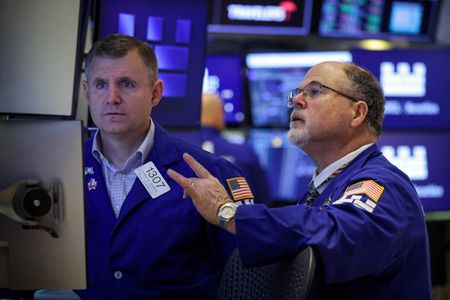By Tom Westbrook and Amanda Cooper
SINGAPORE/LONDON (Reuters) -Global shares fell for a fifth day on Wednesday, after another selloff driven by nerves over AI valuations, although the mood was cautious ahead of what could be make-or-break earnings from chip titan Nvidia and U.S. jobs data this week.
The tech-heavy Nasdaq fell 1.2% overnight, marking a second straight daily decline. Worries about lofty valuations have knocked it more than 6% below late October’s record peak. In the European morning, S&P 500 futures and Nasdaq 100 futures were almost unchanged on the day.
The STOXX 600 fell 0.2%, having fallen 4% from record highs less than a week ago, while in Asia, Japan’s Nikkei ended the day down 0.34%, bringing losses for November so far, in U.S. dollar terms, to 7%.
MSCI’s All-World index was down another 0.1%, easing for a fifth straight session in its longest stretch of daily losses since August.
EYES ON NVIDIA
Nvidia, which sells the graphics processing units underpinning artificial intelligence, has been at the heart of a rally that has carried stock markets around the world to all-time highs and lifted any stock with even tangential links to AI.
It reports after the market close in the U.S. and is expected to deliver a 56% jump in its fiscal August-October quarter revenue to $54.92 billion, according to data compiled by LSEG.
“It looks like Nvidia’s stock price has been priced for perfection, so GPU demand must continue to grow strongly for many more years for the stock to stay up,” said Wong Kok Hoi, founder and CEO of APS Asset Management in Singapore.
Nvidia shares were little changed in Frankfurt on Wednesday, pointing to a smooth start to trading in the U.S. pre-market later.
Nvidia results could set the tone for risk sentiment for the near term, and not just in equities.
“Given the current positive correlation between equities and the dollar (which reflects perhaps the renewed concerns over a tech/AI-specific correction hitting the broader U.S. economy) a bad earnings report this evening could drive the dollar weaker,” MUFG strategist Lee Hardman said, adding that the focus would likely then rapidly pivot to Thursday’s delayed U.S. employment data.
FED OUTLOOK
The dollar has fallen by 8.1% this year, heading for its worst performance against a basket of currencies since 2017. Year-to-date losses topped more than 10% in October, but the dollar has been steadily clawing higher since then, as uncertainty over the economic outlook and persistent inflation have tempered expectations for rate cuts and the stock market bull run has started to stall.
The Japanese yen, which was trading around 155.64 on Wednesday, has given up almost all of this year’s gains against the dollar and prompted officials in Tokyo to warn about the prospect of intervention.
Investors also worry that U.S. President Donald Trump’s falling approval rating could drive fiscal spending and possibly stoke inflation, which has kept safe-haven U.S. Treasuries in check. The benchmark 10-year note was steady at 4.12%, having barely moved so far this month.
Markets are pricing about a 42% chance of a 25-basis point Federal Reserve rate cut in December, something that was priced as a near certainty a month ago.
BITCOIN BOUNCES BACK FROM BELOW $90,000
Meanwhile bitcoin has recovered slightly from Tuesday’s seven-month lows to trade at $91,400. That’s still down about 27% from October’s record high.
“BTC has erased this year’s gains and then some, meaning anybody who acquired in the past 10 months is underwater,” said Justin d’Anethan, head of research at Arctic Digital, a crypto investment and advisory firm.
In commodities, gold, which scaled record highs alongside stocks in October, has also fallen. It was last up 0.4% at $4,080 an ounce, while Brent crude futures eased 0.76% to $64.41 a barrel and soybean futures traded around 17-month highs after China made hefty purchases of U.S. supplies. [O/R][GRA/][GOL/]
(Additional reporting by Tom Westbrook in Singapore; Editing by Sonali Paul and Alex Richardson)











